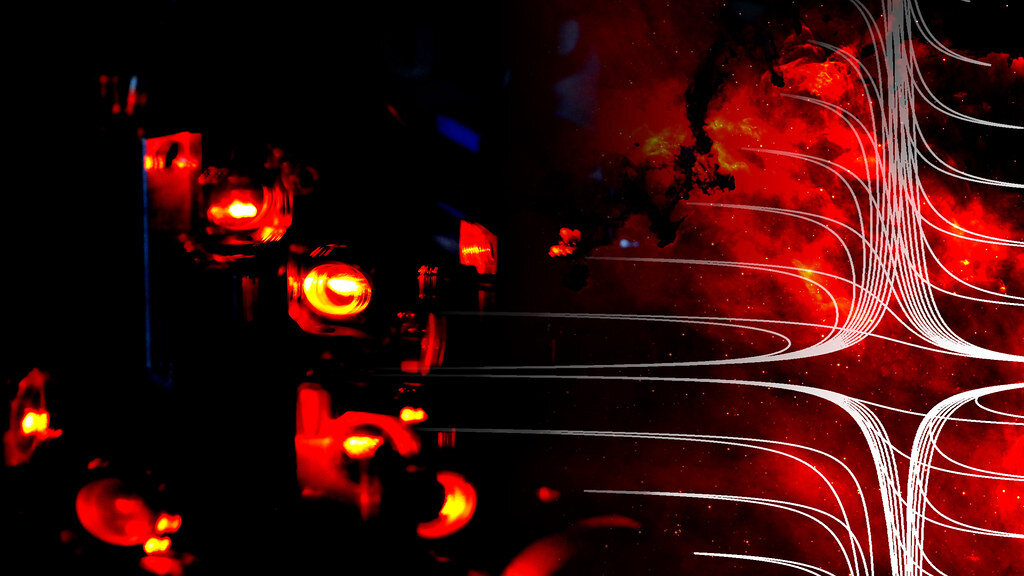
[ad_1]

Photon-photon polaritons in microresonators. Credit: University of Bath
Scientists at the University of Bath in the UK have found a way to bind two photons of different colors together, paving the way for significant advancements in quantum electrodynamics – the field of science that describes how light and matter interact. Over time, the team’s findings are likely to impact developments in optical and quantum communication, as well as precision measurements of frequency, time, and distance.
Apple and wave: they both have a mass
An apple falling from a tree has speed and mass which together give it momentum. The energy of the apple derived from movement depends on the momentum and mass of the fruit.
Most people find the concept of momentum and energy (and therefore mass) easy to grasp when paired with solid objects. But the idea that non-material objects, such as light waves (everything from sunlight to laser radiation), also have mass surprises many. Among physicists, however, this is a well known fact. This seemingly paradoxical idea that waves have mass marks the point where quantum physics and the physical world come together.
Wave-particle duality, proposed by French physicist Louis de Broglie in 1924, is a powerful concept that describes how each particle or quantum entity can be described as a particle or wave. Many so-called quasi-particles have been discovered that combine either two different types of particles of matter or light waves bound to a particle of matter. A list of exotic quasi-particles includes phonons, plasmons, magnons, and polaritons.
The team of physicists in Bath have now reported a way to create quasiparticles that bind two different colored particles of light together. They named these formations photon-photon polaritons.
Detection of photon-photon polaritons
The possibility of discovering and manipulating photons-photons is made possible by the relatively new development of high-quality microresonators. For light, microresonators act like miniature racetracks, with photons zipping around the internal structure in loops. The signature left by photons-photons in the light coming out of the microresonator may be linked to the Autler-Townes effect, a particular phenomenon in quantum theory which describes strong photon-atom interactions. To achieve this effect in microresonators, a laser is tuned to the specific resonant frequency at which a photon should be absorbed, but no resonance absorption occurs. Instead, the photon-photon interaction forms two new resonant frequencies away from the old one.
An important feature that emerged from Bath’s research is that the microresonator provided a complete set of separate resonances, where each photon-photon pair displayed its own momentum and energy, allowing researchers to apply the concept of quasiparticle and to calculate the mass. According to the researchers’ predictions, photons-photons are more than 1000 times lighter than electrons.
Professor Dmitry Skryabin, the physicist who led the research, said: “We now find ourselves in a situation where microresonators – which are millimeter-scale objects – behave like giant atoms. The concept of artificial atoms is rapidly gaining ground in microwave quantum electrodynamics in superconducting circuits, as here we examine the similar opportunity in the optical frequency domain.
“The small mass of photons-photons could lead to new developments of many important analogies between light and fluids, where other families of quasi-particles have already been used.”
PhD student Vlad Pankratov, who participated in the project, said: “After a year of running models and collecting data, these are incredibly exciting discoveries for us. Potential applications of our results are in terabit and quantum optical communication schemes, and in the field of precision measurements. “
The article “Photon-photon polaritons in χ (2) microresonators” is published in Physical examination search.
Physicists refine light storage to create rainbows of color
DV Skryabin et al. Photon-photon polaritons in microresonators χ (2), Physical examination search (2021). DOI: 10.1103 / PhysRevResearch.3.L012017
Provided by the University of Bath
Quote: Photon-photon polaritons: the intriguing particles that emerge when two photons couple (2021, March 2) retrieved March 4, 2021 from https://phys.org/news/2021-03-photon-photon-polaritons-intriguing- particles- emerge.html
This document is subject to copyright. Other than fair use for private study or research purposes, no part may be reproduced without written permission. The content is provided for information only.
[ad_2]
Source link